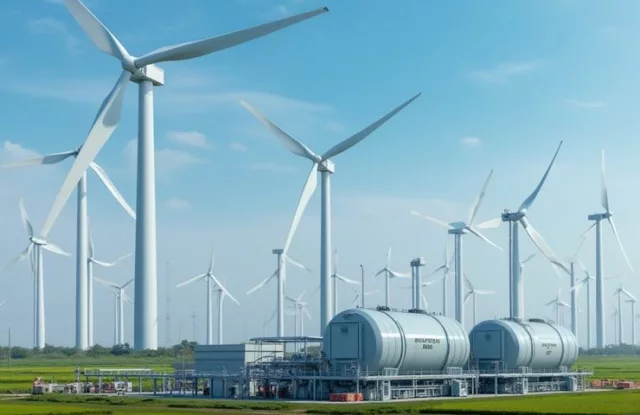
Can a breezy rice field spark China’s hydrogen revolution?
Sometimes, clean energy shows up in the unlikeliest of places. Take Pengze County in Jiangxi Province—a region better known for rice farming than cutting-edge innovation. These days, though, wind turbines now tower over the paddies, and they’re not just spinning for show. They’re helping power green hydrogen production, as China’s electricity heavyweight SPIC turns this quiet corner into a living lab for the future of renewable hydrogen.
So, what’s going on?
On April 30, 2025, the State Power Investment Corporation (SPIC) opened up a bid for 100Nm³/h of PEM electrolysis gear. That may sound small in the global scheme of things, but don’t be fooled—it’s a smart next move in a much bigger game plan. The equipment will soak up excess wind energy from a 100MW farm during off-peak hours—about 2,000 hours a year—turning it into ultra-pure hydrogen (that’s 99.999% pure, for the record) to feed local industries that are hungry for clean fuel alternatives: think electronics, chemicals, and transport.
Two contenders made the final cut: up-and-comer Changchun Ludong Hydrogen Energy, aiming to win with a ¥5.88M bid, and veteran CRRC Zhuzhou Electric Locomotive Research Institute, coming in at ¥6.67M.
Why it actually matters
Sure, on paper a single PEM unit may not make headlines—but step back, and you’ll see it’s part of a much larger mosaic. China is aiming to crank out 200,000 tons of green hydrogen per year by 2025. This particular project is expected to contribute just about 440 tons—a small slice at 0.2%—but one that pulls serious strategic weight:
- Takes a bite out of wind curtailment in Jiangxi, where up to 17% of wind energy goes unused.
- Helps power up China’s “Hydrogen Valley” initiative—a growing cluster of pilot projects that could shape national energy policy.
- Cranks up homegrown PEM competition, shaking up a market still dominated by alkaline players like LONGi.
Digging into the tech
At the heart of all this is PEM (Proton Exchange Membrane) electrolysis. It’s a sleek, fast-acting tech that plays especially well with renewables. Unlike traditional alkaline systems, PEM units can fire up from zero to full throttle in under five minutes—perfect for chasing whatever the wind throws at you.
SPIC is asking bidders to use proprietary PEM stacks—a quiet but clear signal it’s betting on Chinese tech. After years of importing stacks from the U.S., Europe, and Japan, this feels like a turning point: homegrown hydrogen hardware is finally stepping into the ring.
Bigger moves behind the scenes
Let’s zoom out again. These kinds of tenders show that the market’s appetite is shifting—from just selling electrolyzers to offering all-in-one systems, including compression, storage, and hydrogen filling equipment. For companies wanting turnkey solutions—whether they’re fueling trucks or powering chemical plants—that makes life a whole lot easier.
There’s also a little friendly competition in play. While Changchun Ludong is still earning its stripes, CRRC Zhuzhou has serious engineering cred, thanks to its rail and traction tech background. Watch this space—there could be some bold partnerships or surprising mergers on the horizon.
Why Pengze, of all places?
You might be wondering, why stick this project in the middle of Jiangxi? Turns out, it’s a pretty smart choice. The province ranks sixth for wind resources in China, with consistent, workable speeds of around 6.5 m/s at 100 meters. Even more importantly, Jiangxi sits along the strategic Yangtze River Economic Belt, which makes it a natural artery for distributing hydrogen across east-central China.
As for Pengze County itself, it’s already leaning into its transformation. Traditionally a hub for agriculture, it’s now getting ready to roll out 12 hydrogen infrastructure projects by 2028—including its very first hydrogen refueling station by 2026.
The strategy behind SPIC’s play
This isn’t a one-off. It’s part of a sweeping hydrogen roadmap from SPIC, which laid out a $15 billion hydrogen strategy back in 2023. The company has its sights set on installing 10GW of electrolyzers by 2030—enough to make a real dent in both industrial decarbonization and power grid emissions.
By embedding hydrogen production within wind farms, SPIC is solving two problems at once: what to do with surplus renewable power, and how to future-proof against rising carbon costs and fossil fuel uncertainty.
PEM’s moment to shine?
If this pilot proves it can deliver, it could really start to shift how China invests in R&D. Right now, alkaline systems make up about 60% of China’s hydrogen electrolysis market, with heavy hitters like LONGi leading the charge. But PEM electrolysis offers something that’s getting harder to ignore: speed, flexibility, and super-clean output.
Also worth noting—none of the shortlisted vendors were foreign. That’s a clear nod to Beijing’s growing focus on import substitution. With domestic firms now being encouraged (and in some cases required) to deliver proprietary PEM stacks, there’s growing pressure to scale fast and stay competitive.
Parting thoughts
We often picture hydrogen infrastructure as some distant, massive overhaul waiting to kick off. But if you really start looking, you’ll see it’s already quietly taking shape—project by project, contract by contract, in places just like Pengze.
Jiangxi’s wind-powered hydrogen pilot might seem small for now, but don’t blink. This is how big energy transitions begin—not with fanfare, but with the quiet hum of turbines and the buzz of opportunity.
Spread the love
Source: hydrogenfuelnews.com








